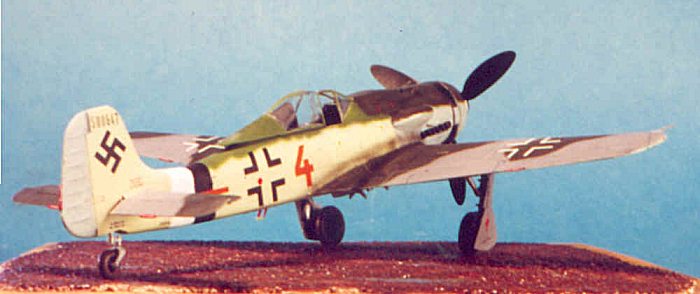
|
KIT: |
Italeri 1/48 Fw-190D-0 |
|
KIT # |
856 |
|
PRICE: |
$28.00 |
|
DECALS: |
Superscale 48-459 |
|
REVIEW & |
|
|
NOTES: |
Wurger Mechanic Late Production Fw-190D-9 set |

DORAS WITH (^) AND WITHOUT (v) THE GOODIES

|
HISTORY |
The Lang-Nasen Dora and the Luftwaffe:
The Lang-Nasen Dora could possibly have entered Luftwaffe service in 1943, had Kurt Tank been less insistent on fighting the Reichluftfahrtministerium (RLM) over the powerplant of the new development of the famous "Butcher Bird." Had this happened, the airplane might have had more effect on the war, as it would have outclassed both the P-38 and the P-47 - the two escort fighters of the 8th AF at the time - and would have been more than a handful for the P-51B Mustang when it came along, particularly since the quality of pilots in 1943 would have been far better than those who flew it during the final seven months of the war when it saw widespread service.
The Dora-9 served with the best units the Luftwaffe had to offer, but by the fall of 1944, these units were mere shadows of their former selves.
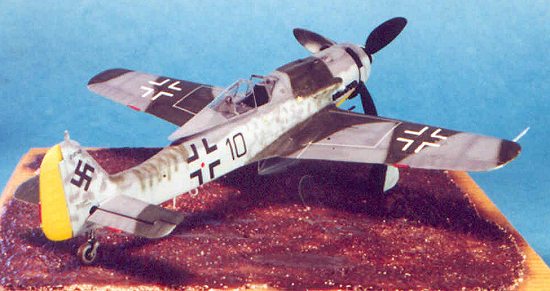 The first unit to equip
with the new fighter, in September and October 1944, was III/JG54, commanded by Hauptmann
Robert "Bazi" Weiss. The unit had been the outstanding Jagdgruppe
in the fighting over Normandy the previous summer, but the success had come at a
high price, with the unit scoring about a 2:1 kill ratio and losing the last of
its experienced pilots at the level below staffelkapitaen. The unit that
took delivery of the first Dora-9s had a core of successful veterans, staffelkapitaene
such as Leutnant Peter Crump, who had joined JG26 on the Channel
Front in 1942, but all the rest were Nachwuchs - "new growth" -
young pilots fresh from flight school with less than 200 hours total flight time
whose major accomplishment was not crashing the high-performance fighters they
were assigned. After the blood-letting of "The Battle of Germany" in
the Spring of 1944, when the fighters of the Eighth Air Force had shot down and
killed 40 percent of their Luftwaffe opponents, the Luftwaffe had paid the price
of not having planned for a long war in their replacement training.
The first unit to equip
with the new fighter, in September and October 1944, was III/JG54, commanded by Hauptmann
Robert "Bazi" Weiss. The unit had been the outstanding Jagdgruppe
in the fighting over Normandy the previous summer, but the success had come at a
high price, with the unit scoring about a 2:1 kill ratio and losing the last of
its experienced pilots at the level below staffelkapitaen. The unit that
took delivery of the first Dora-9s had a core of successful veterans, staffelkapitaene
such as Leutnant Peter Crump, who had joined JG26 on the Channel
Front in 1942, but all the rest were Nachwuchs - "new growth" -
young pilots fresh from flight school with less than 200 hours total flight time
whose major accomplishment was not crashing the high-performance fighters they
were assigned. After the blood-letting of "The Battle of Germany" in
the Spring of 1944, when the fighters of the Eighth Air Force had shot down and
killed 40 percent of their Luftwaffe opponents, the Luftwaffe had paid the price
of not having planned for a long war in their replacement training.
Robert "Bazi" Weiss was a real experte of the old school. He had flown with JG26 back in the glory days when the unit was known by the RAF as "The Abbeville boys", in 1941-42, during which service he scored 26 kills. He had then gone to the Eastern front, where he scored nearly 100 kills in a year's combat before returning to take command of II/JG54 during the invasion.
Once the unit had worked up on their Doras, they moved to Hesepe, where they were to provide air cover for the Me-262s of the Kommando Nowotny, the Luftwaffe's first jet fighter unit. Unfortunately, the inexperience of the majority of the pilots showed badly in fighting during late October and November, and by mid-November they were withdrawn after no success and having seen the death of Nowotny himself in combat with Eighth Air Force Mustangs, to re-equip with pilots and train them.
On December 27, 1944, III/JG54 returned to operational status, assigned as a "fourth gruppe" to JG26, based at Varrelbusch. On their first mission, Ltn. Crump lost five of his Nachwuchs to Tempests of the New Zealand 486 Squadron, when Weiss positioned them down-sun with an unseen enemy. As Crump remembered it, "eight Tempests took on more than sixty of the latest German fighter, and at the end of the fight for a loss of two, they took five of ours." 486 Squadron only lost one aircraft in the fight, despite Crump's claim of two.
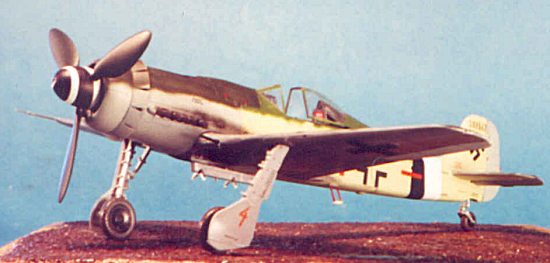 The Tempest and the
Dora-9 would become deadly enemies for the rest of the war. Remarkably similar
in performance, it was generally a case of victory to the better pilot - which
meant that those German experten still left scored well, and that the
Tempests went through the Nachwuchs like a scythe.
The Tempest and the
Dora-9 would become deadly enemies for the rest of the war. Remarkably similar
in performance, it was generally a case of victory to the better pilot - which
meant that those German experten still left scored well, and that the
Tempests went through the Nachwuchs like a scythe.
December 29 was "der schwartz Tag" for III/JG54. The orders called for a mission by successive staffeln against British fighter-bombers in the area of Osnabrueck, Muenster and Rheine, at a specified altitude of 6,000 feet. The mission was madness, considering the superiority of the RAF. Contrary to standard practice, Weiss as the mission commander was not allowed input in the planning; he could have refused these orders and tried to get them revised to allow for a Gruppe-strength patrol at 25,000 feet, which would have given them a chance. For unknown reasons, he accepted the mission as ordered.
Weiss led his stabschwarm and the twelve fighters of 11.JG54 from Varrelbusch at 1000, following the decimation of 9.JG54 twenty minutes earlier by Spitfires from 411 Squadron, which shot down 6 of the 12 German fighters. At 1045, Weiss' formation made contact with Typhoons of 439 Squadron, RCAF, and attacked. They were in turn hit by Tempests of 56 Squadron. Following the initial encounter, the Germans broke into schwaerme. The formation Weiss was leading was then hit by 56 Squadron Tempests and Spitfire XIVs of 41 Squadron. In the entire fight, the Tempests and Spitfires shot down a total of seven pilots from the Stab and 11.JG54, including Hauptmann Weiss. Overall, on December 29, III/JG54 lost fourteen pilots killed and seventeen aircraft, from a total establishment of 36. In the opinion of the group's survivors, the unit never fully recovered from the loss of the popular and well-respected Weiss, a Knight's Cross recipient with 121 victories at the time of his death.
JG26 Carries On:
II/JG26 had been withdrawn from operations in November 1944, to become the second Jagdgruppe to convert to the Dora-9. They were followed in early December by I/JG26, which was not withdrawn from operations during its conversion process. By the time the Battle of the Bulge opened on December 16, 1944, the two premier Fw-190 Gruppen on the western front were fully equipped with the latest version of the Butcher Bird.
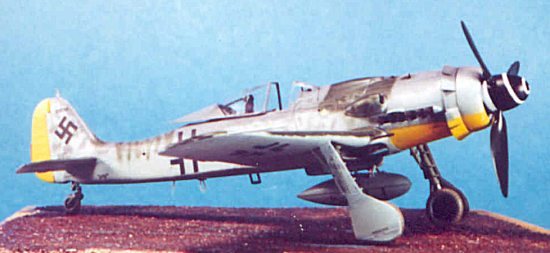 The two units
participated in the last large-scale Luftwaffe attack of the war, Operation
Bodenplatte, the New Year's Day mission against the Allied airfields in
Belgium that should have opened the German offensive two weeks earlier, and
could as well have been planned by the Allies - given its effect on the Jagdwaffe
- as by the incompetent General Dietrich Pelz, a bomber commander who now had
Goering's ear. The Allies' aircraft losses were made up within a week; the Jagdwaffe
never recovered in the rest of the war. Thirty percent of the German Gruppenkommandure
and Staffelkapitaene formation leaders were among those killed or taken
prisoner.
The two units
participated in the last large-scale Luftwaffe attack of the war, Operation
Bodenplatte, the New Year's Day mission against the Allied airfields in
Belgium that should have opened the German offensive two weeks earlier, and
could as well have been planned by the Allies - given its effect on the Jagdwaffe
- as by the incompetent General Dietrich Pelz, a bomber commander who now had
Goering's ear. The Allies' aircraft losses were made up within a week; the Jagdwaffe
never recovered in the rest of the war. Thirty percent of the German Gruppenkommandure
and Staffelkapitaene formation leaders were among those killed or taken
prisoner.
After the retreat from France, JG26 had become a frontline Geschwader, facing the British of 2TAF in the low countries after the lines stabilized following the failure of Operation Market Garden. In the terrible winter that followed Bodenplatte, the unit never flew more than 4-5 missions a month due to weather, and suffered losses of 25-30 percent each time, though their kill ratio was still on the level of 1.5:1 in their favor during this time. What was happening was, the experienced survivors like Adolf "Addi" Glunz - who scored over 80 kills as an enlisted pilot between 1941 and 1944 with JG26 while becoming the only German experte on the Western Front to never be shot down - were scoring as they had, due to the fact the Allies were scraping the bottom of the barrel, too, while a Nachwuchs like Obergefreiter Werner Molge, at 19 the youngest pilot in JG26 and considered something of a "mascot" by the other pilots, was lucky to survive any mission flown against pilots who had a minimum of three times as much flight experience as he did. Battles at this time were short and sharp, in bad weather, with losses high on both sides. Between their arrival on the continent shortly before the opening of the Battle of the Bulge and the end of the war, the Tempests of 84 group - whose mission was "air superiority" over the Luftwaffe - suffered 115% losses in pilots killed, wounded and taken prisoner. The air war over northwestern Europe at the end of the war was as bloody as anything that happened over the Somme a generation before.
When the Allies crossed the Rhine at Remagen in March, 1945, following it at the end of the month with "Operation Varsity," the crossing of the lower Rhine, the end of World War II in Europe was in sight. JG 26 withdrew progressively to fields in Schleswig, just south of Denmark. Fuel was at a premium, and few flights were flown, though some victories were still obtained. On April 4, 1945, 7.JG26 caught allied armor near their former base of Nordhorn, and were able to make a bombing strike that took out ten enemy tanks with no losses to the Germans. Two days later, IV/JG26 - which had been III/JG54 until late February 1945 - was disbanded and its surviving pilots absorbed into I/JG26. A week later, III/JG26 - which had only exchanged its Bf-109K-4s for Fw-190D-9s a month earlier - was also disbanded and its pilots sent to flesh out II/JG26.
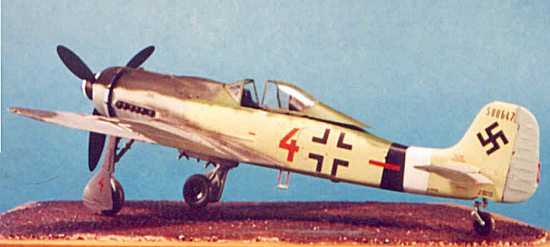 By this point, there
were no Eastern and Western fronts left for the Germans. JG26 pilots were flying
missions over Berlin in mid-April, fighting the Russians. On April 25, 1945, Leutnant
Siegfried Sy of 7th Staffel, II/JG26, scored the 903rd and last victory of the
most successful Fw-190 Gruppe of the Luftwaffe - a Russian P-39 Airacobra
- over Berlin. On April 26, 2nd Staffel of I/JG26 staged in to the former
Luftwaffe test center at Rechlin, then flew a special mission into Berlin. A
13th Fw-190D-9 accompanied them, flown by General Robert Ritter von Greim, with
the well-known aviatrix Hanna Reitsch crammed into the baggage compartment; it
was the first stage of their lunatic mission to the Fuehrerbunker in
Berlin, which resulted in von Greim being named head of the Luftwaffe after
Hitler ordered the arrest of Goering when it was discovered he was attempting to
negotiate to surrender in the West.
By this point, there
were no Eastern and Western fronts left for the Germans. JG26 pilots were flying
missions over Berlin in mid-April, fighting the Russians. On April 25, 1945, Leutnant
Siegfried Sy of 7th Staffel, II/JG26, scored the 903rd and last victory of the
most successful Fw-190 Gruppe of the Luftwaffe - a Russian P-39 Airacobra
- over Berlin. On April 26, 2nd Staffel of I/JG26 staged in to the former
Luftwaffe test center at Rechlin, then flew a special mission into Berlin. A
13th Fw-190D-9 accompanied them, flown by General Robert Ritter von Greim, with
the well-known aviatrix Hanna Reitsch crammed into the baggage compartment; it
was the first stage of their lunatic mission to the Fuehrerbunker in
Berlin, which resulted in von Greim being named head of the Luftwaffe after
Hitler ordered the arrest of Goering when it was discovered he was attempting to
negotiate to surrender in the West.
Heavy rain restricted flying for the rest of the war. The last combat mission flown by JG26 came on May 4, 1945, an indecisive flight in rain. That night, JG26 was ordered by von Greim to fly to Prague, an idiotic mission that would have had the unit land on airfields controlled by the Russians. Major Karl Borris, the by-the-book Kommandeur of I/JG26 faced a mutiny by his pilots when he said they would follow orders; bad weather prevented the flight and provided an excuse not to court-martial the mutineers. II/JG26 had no Kommandeur, since their last had been killed on April 25. Some of the pilots - led by avowed Nazi Ltn. Sy - flew to Bergen, Norway, before the armistice became final on May 5. On May 6, Major Borris led his men in a surrender to the British at Flensburg. The remaining pilots of II/JG26 surrendered the following day.
|
THE KIT |
The Trimaster Fw-190D-9, rereleased by DML following Trimaster's demise, was the first accurate Dora-9 model in 1/48. Considering the number of inaccuracies in Tamiya's competitive model - prop, spinner, landing gear, lower wing, etc. - there is a strong argument that this is still the only accurate 1/48 Fw-190D-9 kit. While Bob Stephenson does have a resin aftermarket set for the kit, the truth of the matter is that using it refines an already-good model, as I shall demonstrate here with two different Dora-9s, both made from the DML kit (in its Italerei release), one using aftermarket goodies and one not. You be the judge. The one major difference is that Bob adds a Ta-152 style vertical fin and rudder, which was utilized on some late-production Dora-9s.
|
CONSTRUCTION |
Construction of both kits is straightforward, with substitution of Bob Stephenson's resin parts for the kit parts; these resin parts actually fit the kit fuselage better than the originals did.
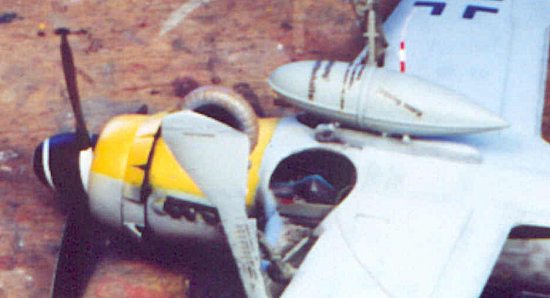 In both cases, I cut out
the center section of the wheel wells, since I had also in the meantime obtained
two of Bruce Raudebaugh's resin engine plugs, which go a long way toward making
the Dora-9 look right - whether or not you use any other aftermarket part. The
plug will fit either the Tamiya or DML kits, and I highly recommend it. While I
doubt you can really see it in the accompanying photos (since I don't have
extreme close-up capability), let me assure you it looks good in there, and I
would have used them on all my other in-line Fw-190 models had I had it at the
time. The only "problem" associated with the use of the plug is, you
need to cut back the floor of the cockpit about 1/16", and you should then
"wall it off" with some sheet styrene so that light from the open
wheel wells doesn't illuminate the cockpit incorrectly.
In both cases, I cut out
the center section of the wheel wells, since I had also in the meantime obtained
two of Bruce Raudebaugh's resin engine plugs, which go a long way toward making
the Dora-9 look right - whether or not you use any other aftermarket part. The
plug will fit either the Tamiya or DML kits, and I highly recommend it. While I
doubt you can really see it in the accompanying photos (since I don't have
extreme close-up capability), let me assure you it looks good in there, and I
would have used them on all my other in-line Fw-190 models had I had it at the
time. The only "problem" associated with the use of the plug is, you
need to cut back the floor of the cockpit about 1/16", and you should then
"wall it off" with some sheet styrene so that light from the open
wheel wells doesn't illuminate the cockpit incorrectly.
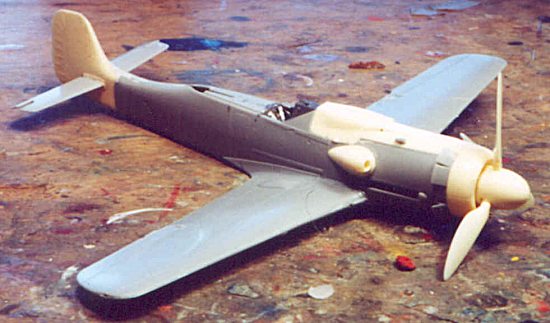 The only place where
the DML kit presents any problem in assembly is that the fuselage section that
fits to the lower fuselage extension of the lower wing part is open, which means
you can press it together and fail thereby to get a good join on the upper
wing-fuselage joint, which will then require the use of putty to get a smooth
fit. The solution is to cut off a piece of sprue and brace the fuselage just aft
of the cockpit, to push out the sides sufficiently for a good join on the upper
wing; test-fit the brace, when you have it right, glue it in position. If you
have done it right, you will not need any putty or anything else on this
wing-fuselage joint. In fact, on both models, the only thing I had to do was use
Mr. Surfacer 500 along the fuselage center joint to get rid of the seam.
The only place where
the DML kit presents any problem in assembly is that the fuselage section that
fits to the lower fuselage extension of the lower wing part is open, which means
you can press it together and fail thereby to get a good join on the upper
wing-fuselage joint, which will then require the use of putty to get a smooth
fit. The solution is to cut off a piece of sprue and brace the fuselage just aft
of the cockpit, to push out the sides sufficiently for a good join on the upper
wing; test-fit the brace, when you have it right, glue it in position. If you
have done it right, you will not need any putty or anything else on this
wing-fuselage joint. In fact, on both models, the only thing I had to do was use
Mr. Surfacer 500 along the fuselage center joint to get rid of the seam.
I assembled the fuselages, then slipped the cockpits in once they had been painted and assembled. The new plastic instrument panel that Italerei has replaced the DML photoetch part with is not that easy to paint, and I ended up using some instrument decals to take care of the panels. I used Eduard Luftwaffe photoetch seatbelts to enhance the otherwise-stock cockpits.
The only other change I made to the kits was to cut the elevators from the horizontal stabilizers and pose them in the drooped position. When you do something like this, be sure that you push the control stick forward in the cockpit to match that movement.
|
PAINT & DECALS |
Painting:
The "stock" kit was going to be done as Robert "Bazi" Weiss' airplane, an early-production Dora-9, while the modified kit would be a late-production airplane.
Both models were pre-shaded with flat black airbrushed around panel lines. I then painted the lower wing, landing gear, inside of the gear doors and the wheel wells of the late version with SnJ aluminum. The lower surfaces of the Weiss airplane were painted overall RLM 76, while I painted the cowling, lower surfaces of the ailerons and elevators, and the rudder this color on the late-production airplane.
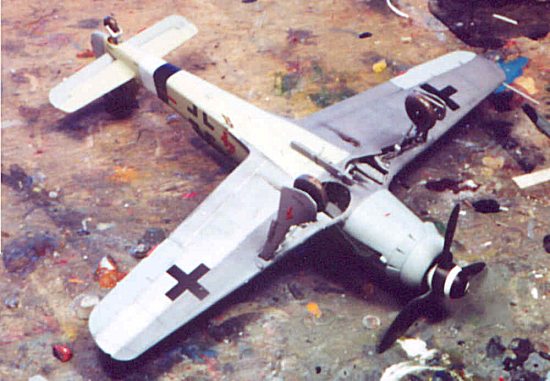 The upper camouflage for
both was RLM75 Grauviolett and RLM83 Dunkelgrun on wings and
elevators, with the fuselage of the Weiss airplane painted with these colors;
the fuselage of the late-production airplane were done with RLM82 Lichtgrun
substituted for the RLM75 and RLM83, while the entire lower right wing and the
forward half of the left wing were painted RLM75, per the painting instructions
on the decal sheet. Both spinners were painted black, and propeller blades in
RLM70 Schwarzgrun. When the paints were all dry, I have the models
overall coats of Future preparatory to applying the decals.
The upper camouflage for
both was RLM75 Grauviolett and RLM83 Dunkelgrun on wings and
elevators, with the fuselage of the Weiss airplane painted with these colors;
the fuselage of the late-production airplane were done with RLM82 Lichtgrun
substituted for the RLM75 and RLM83, while the entire lower right wing and the
forward half of the left wing were painted RLM75, per the painting instructions
on the decal sheet. Both spinners were painted black, and propeller blades in
RLM70 Schwarzgrun. When the paints were all dry, I have the models
overall coats of Future preparatory to applying the decals.
Decals:
I did the Weiss airplane with national insignia out of the decal box, the "black 10" from the SuperScale 48-549 "Focke-Wulf Fw-190D-9 Aces," which is the only sheet that provides this number for Weiss' airplane in the correct style and size. I used the kit decal sheet for all stencilling.
I did the late production airplane as "Brown 4" of 7th Staffel, JG-26, from the Eagle-Cals sheet. Eagle-Cals, if you haven't used them before, are beautiful, thin (printed by MicroScale and they're willing to stand in line and wait to get the Micro-Scale touch) and very accurate. Aviation artist Jerry Crandall, who designs them, is a well-known researcher, and his results are impeccable.
Final Finish and Weathering:
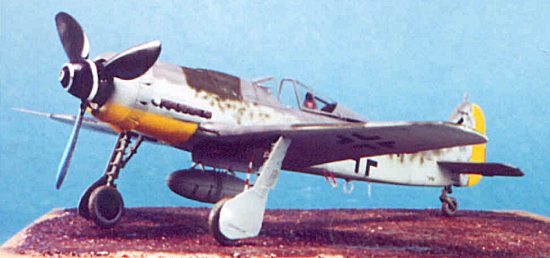 I figured of the two
airplanes, that flown by Hauptmann Weiss between September-December 1944 had
likely seen the more use, while the other airplane was likely delivered in late
February, early March, and did not see that much service prior to the end of the
war. I therefore dinged up the earlier airplane, with some chips on the leading
edge of the wing, along the piano hinges of various panels, the area of the wing
where the pilot stood to enter the cockpit, etc. The other airplane had some bar
metal showing on hinge lines and the step area. Both received exhaust staining
and gunfire residue. I attached the landing gear, with wheels suitably muddied
for both. The Weiss airplane, which used a "flat top" canopy, got one
from the spares box, that I think originated with a Tamiya kit, though I used
the headrest and brace from the DML kit, since it is more accurate.
I figured of the two
airplanes, that flown by Hauptmann Weiss between September-December 1944 had
likely seen the more use, while the other airplane was likely delivered in late
February, early March, and did not see that much service prior to the end of the
war. I therefore dinged up the earlier airplane, with some chips on the leading
edge of the wing, along the piano hinges of various panels, the area of the wing
where the pilot stood to enter the cockpit, etc. The other airplane had some bar
metal showing on hinge lines and the step area. Both received exhaust staining
and gunfire residue. I attached the landing gear, with wheels suitably muddied
for both. The Weiss airplane, which used a "flat top" canopy, got one
from the spares box, that I think originated with a Tamiya kit, though I used
the headrest and brace from the DML kit, since it is more accurate.
|
CONCLUSIONS |
These two airplanes could be considered "die Erste und die Letzte" of Fw-190D-9s, since Bazi Weiss scored the first victory by a Dora-9 pilot, while Siegfried Sy, who scored the last victory for II/JG26, might well have accomplished that in feat in "Braun Vier," since he was attached to 7th Staffel at the time. In markings and construction, they certainly are the first and the last of Dora-9s.
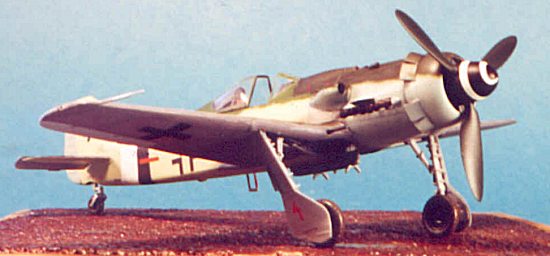 Sitting side-by-side and
using the "one foot rule," i.e., if it looks good at a distance of one
foot it is, the two models are nearly indistinguishable. On closer examination,
the resin parts for the upper gun bay and forward fuselage and the resin prop
from Bob Stephenson give that kit an overall "finer" look. The plastic
prop blades of the DML kit, compared to the resin ones, are overall a bit
clunkier in appearance. Will you be very happy if you do a Dora-9 out of the box
with the DML Kit? Of course you will, though I highly recommend aftermarket
decals. The Stephenson set makes something nice just that much nicer. In both
cases, the engine plugs really make the model look like a Dora should.
Sitting side-by-side and
using the "one foot rule," i.e., if it looks good at a distance of one
foot it is, the two models are nearly indistinguishable. On closer examination,
the resin parts for the upper gun bay and forward fuselage and the resin prop
from Bob Stephenson give that kit an overall "finer" look. The plastic
prop blades of the DML kit, compared to the resin ones, are overall a bit
clunkier in appearance. Will you be very happy if you do a Dora-9 out of the box
with the DML Kit? Of course you will, though I highly recommend aftermarket
decals. The Stephenson set makes something nice just that much nicer. In both
cases, the engine plugs really make the model look like a Dora should.
If I was only going to do one Dora for my collection, I would definitely use the resin parts to make it the best it can be.
To get the parts used on these kits contact:
And, If you haven't had enough 190D-9s for today, you can see how your intrepid editor did with Brown 4 about 2 1/2 years ago using the Tamya kit and Kommandeur's resin tail and decals. Not the same standard at Tom's excellent kits, though.
If you would like your product reviewed fairly and quickly by a site that averages over 2,500 visits a day, please contact me or see other details in the Note to Contributors.